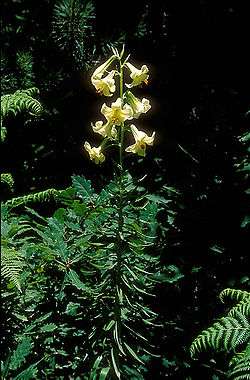Definify.com
Definition 2025
百合
百合
Chinese
| hundred | to close; to gather; to join; to fit; all; together
|
||
|---|---|---|---|
|
simp. and trad. (百合) |
百 | 合 | |
Pronunciation
- Mandarin
- Cantonese (Jyutping): baak3 hap6
- Hakka (Sixian, PFS): pak-ha̍p
- Min Nan (POJ): peh-ha̍p / pek-ha̍p
- Mandarin
- (Standard Chinese, Beijing)+
- Pinyin:
- Zhuyin: ㄅㄞˇ ㄏㄜˊ
- Gwoyeu Romatzyh: baeher
- IPA (key): /paɪ̯²¹⁴⁻²¹¹ xɤ³⁵/
- (Standard Chinese, Beijing)+
- Cantonese
- (Standard Cantonese, Guangzhou)+
- Jyutping: baak3 hap6
- Yale: baak hahp
- Cantonese Pinyin: baak8 hap9
- IPA (key): /pɑːk̚³ hɐp̚²/
- (Standard Cantonese, Guangzhou)+
- Hakka
- (Sixian, incl. Miaoli and Meinong)
- Pha̍k-fa-sṳ: pak-ha̍p
- Hakka Romanization System: bag` hab
- Hagfa Pinyim: bag5 hab6
- IPA: /pak̚² hap̚⁵/
- (Sixian, incl. Miaoli and Meinong)
- Min Nan
- (Hokkien)
- Pe̍h-ōe-jī: peh-ha̍p / pek-ha̍p
- Tâi-lô: peh-ha̍p / pik-ha̍p
- Phofsit Daibuun: pehhap, pekhap
- IPA (Xiamen): /pe(ʔ)³²⁻⁵³ hap̚⁴/, /piɪk̚³²⁻⁴ hap̚⁴/
- IPA (Quanzhou): /pe(ʔ)⁵ hap̚²⁴/, /piɪk̚⁵⁻²⁴ hap̚²⁴/
- IPA (Zhangzhou): /pe(ʔ)³²⁻⁵³ hap̚¹²¹/, /piɪk̚³²⁻⁵ hap̚¹²¹/
- IPA (Taipei): /pe(ʔ)³²⁻⁵³ hap̚⁴/, /piɪk̚³²⁻⁴ hap̚⁴/
- IPA (Kaohsiung): /pe(ʔ)³²⁻⁴¹ hap̚⁴/, /piɪk̚³²⁻⁴ hap̚⁴/
- (Hokkien)
Noun
百合
- (botany) lily
Derived terms
Etymology 2
Borrowing from Japanese 百合 (yuri).
Pronunciation
- Mandarin
- (Standard Chinese, Beijing)+
- Pinyin:
- Zhuyin: ㄅㄞˇ ㄏㄜˊ
- Gwoyeu Romatzyh: baeher
- IPA (key): /paɪ̯²¹⁴⁻²¹¹ xɤ³⁵/
- (Standard Chinese, Beijing)+
- Cantonese
- (Standard Cantonese, Guangzhou)+
- Jyutping: baak3 hap6
- Yale: baak hahp
- Cantonese Pinyin: baak8 hap9
- IPA (key): /pɑːk̚³ hɐp̚²/
- (Standard Cantonese, Guangzhou)+
- Min Nan
- (Hokkien)
- Pe̍h-ōe-jī: iú-lih
- Tâi-lô: iú-lih
- Phofsit Daibuun: iwliq
- IPA (Xiamen): /iu⁵³⁻⁴⁴ liʔ³²/
- IPA (Quanzhou): /iu⁵⁵⁴⁻²⁴ liʔ⁵/
- IPA (Zhangzhou): /iu⁵³⁻⁴⁴ liʔ³²/
- IPA (Taipei): /iu⁵³⁻⁴⁴ liʔ³²/
- IPA (Kaohsiung): /iu⁴¹⁻⁴⁴ liʔ³²/
- (Hokkien)
Noun
百合
- (Taiwanese Min Nan, botany) lily
- (ACG) yuri
Japanese

百合 (yuri): A lily plant.
| Kanji in this term | |
|---|---|
| 百 | 合 |
| Grade: 1 | Grade: 2 |
| Irregular | |
Etymology
Probably the nominalization of the 連用形 (ren'yōkei, “continuative or stem form”) yuri of Old Japanese-derived and now-obsolete verb 揺る (yuru, “to sway, to swing, to wave back and forth”), from the way that lilies tend to grow tall and sway in the breeze.
The spelling is borrowed from Chinese, and indicates the way that lily bulbs cluster together (合 (“gather, combine”)) in large numbers (百 (“hundreds”)).
Pronunciation
Noun
百合 (hiragana ゆり, katakana ユリ, romaji yuri)
- (botany) lily
- the name of a color scheme when wearing multiple layers in the 襲 (kasane, “layering”) style, featuring a red outer layer and a reddish-gold inner layer, and worn in summer (from the way the color scheme resembles the coloration of the petals of certain varieties of lily)
- (slang) yuri
Descendants
- English: yuri
Proper noun
百合 (hiragana ゆり, romaji Yuri)
- A female given name
References
- 1988, 国語大辞典(新装版) (Kokugo Dai Jiten, Revised Edition) (in Japanese), Tōkyō: Shogakukan